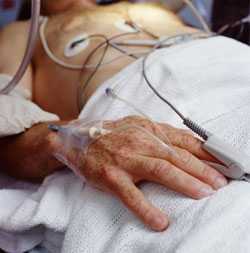Necrotizing Fasciitis

Wounded? See a doctor right away if you have a fever, chills, or vomiting.
Necrotizing fasciitis (neck-ro-tie-zing Fas-e-i-tis) is a serious bacterial skin infection that spreads quickly and kills the body’s soft tissue. (Necrotizing means “causing the death of tissues.”) Unfortunately, necrotizing fasciitis can be deadly in a very short amount of time. Accurate diagnosis, prompt antibiotic treatment (medicine that kills bacteria in the body), and surgery are important to stopping this infection.
Although the media commonly calls it a “flesh-eating infection,” more than one type of bacterium can cause this rare disease. These bacteria include group A Streptococcus (group A strep), Klebsiella, Clostridium, Escherichia coli, Staphylococcus aureus, and Aeromonas hydrophila. Public health experts consider group A strep to be the most common cause of necrotizing fasciitis.
Infections from group A strep bacteria are generally mild and are easily treated. But in cases of necrotizing fasciitis, bacteria spread quickly once they enter the body. They infect the fascia, connective tissue that surround muscles, nerves, fat, and blood vessels. The infection also damages the tissues next to the fascia. Sometimes toxins (poisons) made by these bacteria destroy the tissue they infect, causing it to die. When this happens, the infection is very serious and those infected can lose limbs or die.
Good Wound Care Is Important
Common sense and good wound care are the best ways to prevent a bacterial skin infection.
- Keep draining or open wounds covered with clean, dry bandages until healed.
- Don’t delay first aid of even minor, non-infected wounds (like blisters, scrapes, or any break in the skin).
- Avoid spending time in whirlpools, hot tubs, swimming pools, and natural bodies of water (e.g., lakes, rivers, oceans) if you have an open wound or skin infection.
- Wash hands often with soap and water or use an alcohol-based hand rub if washing is not possible.
People Rarely Spread Necrotizing Fasciitis to Other People
In general, someone with necrotizing fasciitis does not spread the infection to other people. Most cases of necrotizing fasciitis occur randomly. The most common way of getting necrotizing fasciitis is when the bacteria enter the body through a break in the skin. This can include cuts, scrapes, burns, insect bites, or puncture wounds.
While Rare, Some People Are More Likely to Get Necrotizing Fasciitis
Necrotizing fasciitis is rare. Your chances of getting it are extremely low if you have a strong immune system and practice good hygiene and proper wound care.
Most people who get necrotizing fasciitis have other health problems that may lower their body’s ability to fight infection. Some of these conditions include:
- Diabetes
- Kidney disease
- Cancer
- Other chronic health conditions that weaken the body’s immune system
Symptoms Start Quickly, But Can Often Be Confusing
People with necrotizing fasciitis often start having symptoms within a few hours after an injury. The symptoms may seem like another illness or injury. For example, some people may complain of pain or soreness, similar to that of a “pulled muscle.” The skin may be warm with red or purplish areas of swelling that spread rapidly. Some people get ulcers, blisters, or black spots on the skin. Patients often describe their pain as severe and hurting much more than they would expect based on how the wound looks. Later symptoms can include:
- Fever
- Chills
- Fatigue (tiredness)
- Vomiting
These confusing symptoms may delay a person from seeking medical attention. If you have these symptoms after a wound, see a doctor right away.

Doctors treat necrotizing fasciitis with IV antibiotics.
People with Necrotizing Fasciitis Need Prompt Treatment
The first line of defense against this disease is strong antibiotics given through a needle into a vein (IV antibiotics). Antibiotics may not reach all of the infected and dying areas if toxins destroy soft tissue and reduce blood flow. This is why doctors often use surgery—in addition to antibiotics—to remove dead tissue. This surgery is often critical to stop the infection and must happen quickly.
CDC Tracks Necrotizing Fasciitis due to the Most Common Cause
CDC tracks necrotizing fasciitis caused by group A strep with a special system called Active Bacterial Core surveillance (ABCs). Since 2010, approximately 700 to 1100 cases occur each year in the United States. This is likely an underestimate. According to ABCs data, the number of annual infections does not appear to be rising.
ABCs is an important part of CDC’s Emerging Infections Programs network, a collaboration between CDC, state health departments, and universities. By sharing this kind of timely information, public health professionals can stay connected and look for trends in rising cases.
- Page last reviewed: July 3, 2017
- Page last updated: July 3, 2017
- Content source:
- National Center for Immunization and Respiratory Diseases, Division of Bacterial Diseases
- Page maintained by: Office of the Associate Director for Communication, Digital Media Branch, Division of Public Affairs




 ShareCompartir
ShareCompartir